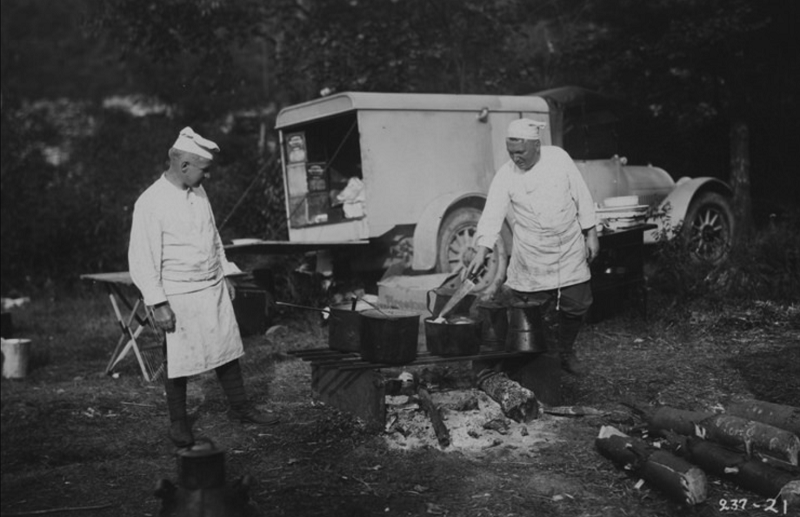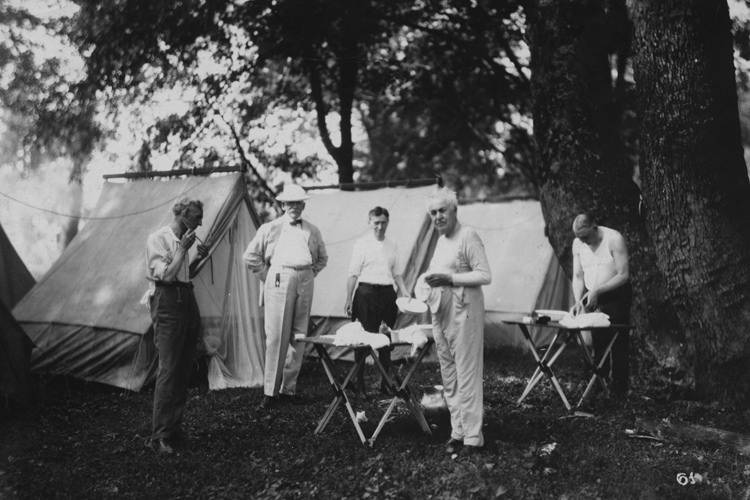
(Ford, Edison, Burroughs, and Firestone)
In 1914 Thomas Edison, Henry Ford, and assorted family members assembled their Ford motor cars and embarked on a camping and exploratory trip of the Florida Everglades. It would begin a decade of exploration of America by the self-proclaimed ‘Vagabonds’ and the beginning of an unprecedented era of recreational travel that would transform America.
The idea for the camping trips seems to have germinated in a trip by the Fords and the Edisons to the Florida Everglades in 1914. It took firm root in California in 1915, when Ford, Firestone, and Edison motored from near Los Angeles to San Diego.
The group so much enjoyed the freedom and fun of motoring that Edison proposed similar “gypsy” trips in future summers. All agreed.
Ford, as it turned out, was too busy to join the 1916 expedition, which included the naturalist John Burroughs. But the auto king joined the 1918 outing to the Great Smokies, and at once became the dominant spirit of this and later excursions.
The 1918 “Vagabonds” (as the campers styled themselves) were Edison, Firestone and his son, Harvey, Jr., Ford, Burroughs, Professor R. J. DeLoach, an expert in plant pathology, and for a time Edward N. Hurley of the United States Shipping Board. They moved along in six cars-two Packards for riding, two Model Ts, and two Ford trucks-plus seven drivers and helpers.

(Built on a 1922 Lincoln Limo chassis, this food truck had an ice box, detachable gas stove, and enough food to feed the group)
The 1918 trip covered a lot of ground, for the vagabonds drove from Pennsylvania down through West Virginia to Tennessee, and then swung over to North Carolina, Virginia, and Maryland, This trip set a pattern for those to follow.
In 1919 the party swung through northern New York, Vermont, and New Hampshire. Along the way the group visited a power site Ford had purchased at Green Island on the Hudson River.
A camping trip was omitted in 1920, although the group had a fall outing at Yama Farms, New York. Then the wives demanded a share in the adventure, and in 1921 a journey through Maryland and Pennsylvania saw Mrs. Edison, Mrs. Ford, Mrs. Firestone, Mrs. Harvey Firestone, Jr., and Mrs. W. F. Anderson (wife of Methodist Bishop William F. Anderson) with the party, as well as President Harding. Mrs. Harding had been invited but could not go.
In 1923 the party visited President Coolidge in Massachusetts, and in late April, 1924, on a journey across the upper peninsula of Michigan, Ford acted as engineer and Firestone as fireman for a train which carried the Fords, Edisons, Firestones, and Edsel Fords to various Ford properties – Iron Mountain, Sidnaw, and L ‘ Anse among them. Later in the year all assembled as Ford’s guests at the Wayside Inn, in Massachusetts, and the men called upon Coolidge in Plymouth, Vermont, who made Ford a gift of a four-gallon maple sap bucket, fashioned about 1780 by one of his ancestors.

The last camping trip took place in 1924. “The trips were good fun,” Ford wrote in his autobiography, My Life and Work, “except that they began to attract too much attention.” Ford’s statement, however, belied his interest in the publicity received by the group. In 1918, for example, he requested that a typewritten report, containing verbatim news stories from all papers in the six states through which the party traveled, be prepared for his perusal. Similarly, it is difficult to believe that many of the contests and hijinks in which the aging vagabonds participated were not staged for the benefit of the nearby reporters and photographers (Edison, little less than Ford, was appreciative of publicity and a top-notch publicist). As Charles E. Sorensen wrote in My Forty Years with Ford: “With squads of news writers and platoons of cameramen to report and film the posed nature studies of the four eminent campers, these well- equipped excursions…were as private and secluded as a Hollywood opening, and Ford appreciated the publicity.”
The trips also had become a formidable undertaking by 1924, what with the wives of the men coming along. The introduction of the women conventionalized the expeditions; they could not be as informal as they had been without them. Mrs. Ford took along a cook, Mrs. Edison a personal maid and chauffeur, and the Firestones a butler and a driver. Harvey Firestone, Jr. also took along riding horses; Ford didn’t care for that. In addition, by 1924, the three surviving members of the original group (Burroughs had died in 1921) were older and, in the case of Ford and Firestone, busier.
Today:
What the Vagabonds did from 1914-1924 would be considered overlanding today. These men were the original overlanders here in the United States. One hundred years later the legacy and spirit of the Vagabonds lives on through a small group of ‘Vagabonds’ here at TheRangerStation.com. To learn more, check out the TRS Vagabonds.

